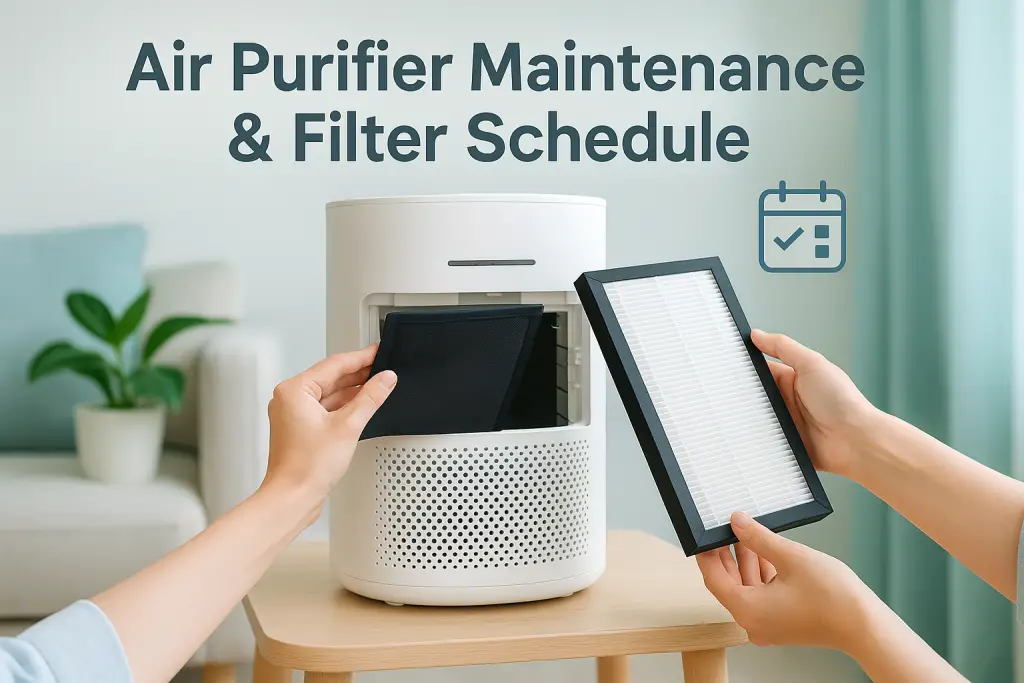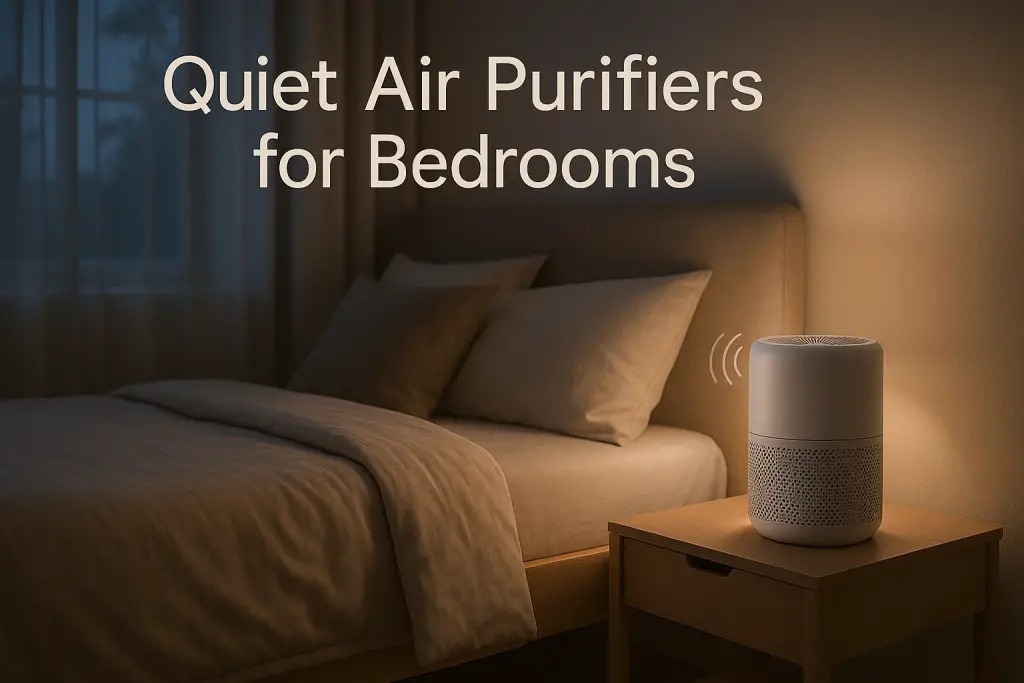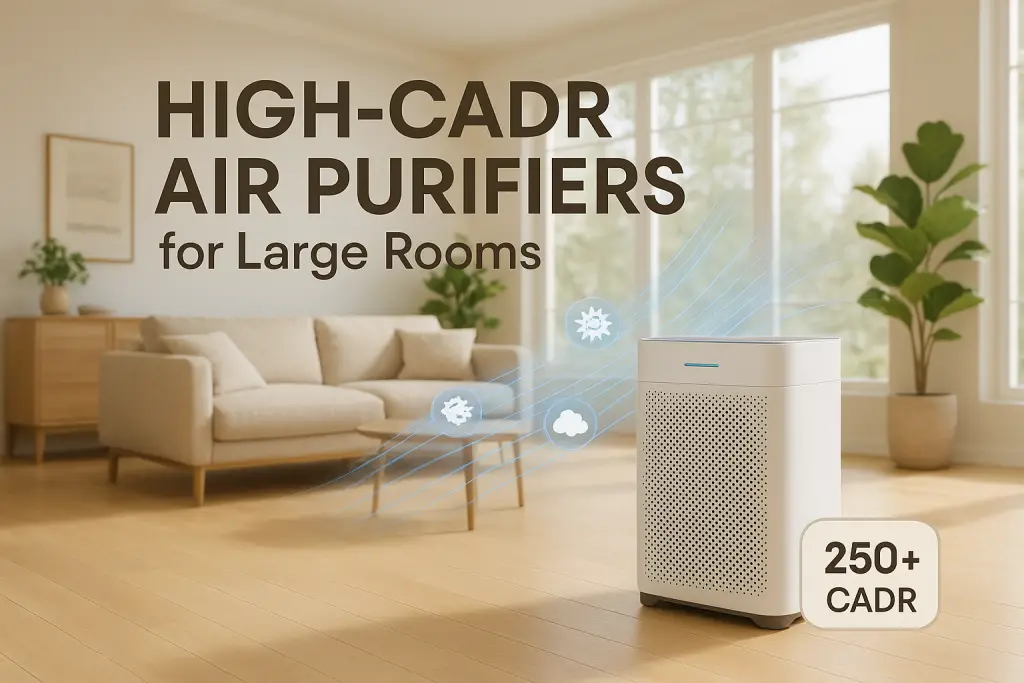Air purifiers can reduce dust settling on furniture, but results vary based on several factors. True HEPA air purifiers can capture up to 99.97% of airborne dust particles that would otherwise land on your furniture. By continuously filtering the air, these devices intercept dust particles before they have a chance to settle, resulting in noticeably cleaner surfaces and less frequent dusting.
Understanding Furniture Dust: Composition, Sources, and Behavior
Before examining how air purifiers affect furniture dust, it’s essential to understand what furniture dust actually is and how it behaves in your home. Household dust isn’t just one thing. It’s a complex mixture that typically consists of 40-60% dead skin cells, 30-40% outdoor particles that enter your home, and the remaining percentage from textile fibers, pet dander, and other sources.
Dust particles range from 0.5 to 100 microns in size. For reference, a human hair is about 70 microns thick. The smaller particles remain airborne longer, while larger particles settle quickly on furniture surfaces.
Primary dust sources in homes include:
- Human skin cells (we shed approximately 30,000-40,000 skin cells per hour)
- Pet dander and fur
- Textile fibers from clothing, bedding, and furniture
- Outdoor particles entering through windows, doors, and on shoes
- Pollen and other airborne allergens that contribute to dust accumulation
- Food particles and cooking residue
Dust circulation follows predictable patterns in your home. When disturbed, particles become airborne and float until they settle again. This constant cycle is why furniture seems to collect dust so quickly after cleaning.
Why Furniture Dust Is Particularly Challenging to Control
Furniture surfaces present unique dust management challenges compared to other household surfaces. Different materials attract and hold dust in various ways:
- Wood furniture (especially unsealed): Creates slight static charges that attract dust particles
- Glass and mirrors: Show dust more visibly despite having less static attraction
- Fabric upholstery: Traps dust within fibers making it harder to remove
- Leather: Develops static electricity that actively pulls dust from the air
- Electronics: Generate electrostatic fields that dramatically increase dust collection
Room traffic significantly impacts dust settlement. Every footstep, sitting down, or door opening disturbs and redistributes dust. Humidity levels also play a role, as drier air increases static electricity, causing more dust to cling to surfaces.
How Air Purifiers Work Against Dust: Mechanism and Effectiveness
Air purifiers combat dust through specific filtration mechanisms, but their effectiveness depends on several critical factors. At their core, air purifiers work by drawing in air, passing it through a series of filters that trap particles, and releasing clean air back into the room.
The most effective air purifiers for dust use True HEPA filters, which can capture 99.97% of particles as small as 0.3 microns. This includes most dust particles that would otherwise settle on furniture. Many units also include pre-filters to catch larger dust particles before they reach the HEPA filter, extending the main filter’s life.
For air purifiers to effectively reduce furniture dust, they must:
- Process enough air volume to cover your room size (measured by Clean Air Delivery Rate or CADR)
- Run continuously to catch dust before it settles
- Be properly placed to create optimal air circulation patterns
- Have regularly maintained filters to ensure maximum efficiency
It’s important to understand the concept of a “capture zone.” An air purifier can only filter the air that passes through it. This creates an effective radius around the unit where dust reduction is most noticeable. Beyond this zone, effectiveness diminishes.
Types of Air Purifiers and Their Dust-Capturing Capabilities
Not all air purifiers are created equal when it comes to dust reduction capabilities. Here’s how different technologies compare:
- HEPA Filtration: Captures 99.97% of particles at 0.3 microns, the most effective for dust removal
- Electrostatic Precipitators: Use an electrical charge to attract particles with 80-95% efficiency but may produce ozone
- Ionizers: Release charged ions that cause dust to fall from the air, 70-80% efficiency for airborne particles
- UV Purifiers: Primarily target germs rather than dust particles, limited effect on dust reduction
- Activated Carbon: Targets odors and gases, not effective for dust by itself
The Clean Air Delivery Rate (CADR) is crucial when selecting an air purifier for dust. This rating indicates how quickly the unit can filter dust from a room. Higher numbers mean faster cleaning. For effective furniture dust reduction, look for purifiers with a dust CADR rating appropriate for your room size (typically at least 100 CADR for smaller rooms and 300+ for larger spaces).
Do Air Purifiers Reduce Dust Settling on Furniture? The Evidence
Based on scientific testing and real-world evidence, air purifiers do reduce dust settling on furniture, but with important caveats. Independent laboratory tests show that properly sized HEPA air purifiers can reduce airborne dust particles by 80-99% in controlled settings.
This airborne particle reduction translates to approximately 20-60% less dust accumulation on furniture surfaces over time. The variation in this range depends on:
- Room size and layout
- Air purifier capacity and filter quality
- Runtime (24/7 operation yields best results)
- Room traffic and activity levels
- External dust sources (open windows, pets, etc.)
Real-world testing shows that homeowners typically notice results after 1-3 weeks of continuous air purifier operation. The most visible improvements occur on dark furniture surfaces where dust is most noticeable.
Homes with pets, multiple occupants, or those located in areas with high outdoor dust levels see the most dramatic benefits from air purification. In these high-dust environments, surface dust reduction can reach the higher end of the effectiveness range (closer to 60% reduction).
Limitations of Air Purifiers for Furniture Dust Control
While air purifiers can significantly reduce dust, they have specific limitations regarding furniture surfaces that users should understand:
- Already-settled dust: Air purifiers can only capture airborne particles. They cannot remove dust that has already settled on furniture.
- Distance limitations: Most air purifiers have an effective range of about 6-10 feet. Furniture beyond this range sees diminished benefits.
- Continuous dust sources: If your furniture itself sheds fibers or your home has constant new dust introduction, an air purifier will help but not eliminate the problem.
- The reintroduction problem: When you walk, sit on upholstered furniture, or create air movement, settled dust becomes airborne again. Air purifiers catch some, but not all, of this recirculated dust.
- Filter maintenance: As filters fill with dust, efficiency decreases. Regular replacement is essential for continued effectiveness.
Air purifiers complement regular dusting but don’t replace it entirely. The realistic expectation should be reduced dusting frequency, not elimination of the need to dust.
Optimal Air Purifier Placement for Maximum Furniture Dust Reduction
Where you place your air purifier significantly affects its ability to reduce dust on your furniture. For best results:
- Central positioning: Place the unit in the center of the room when possible to maximize air circulation
- Proper distance: Position 3-6 feet from the furniture you most want to protect
- Height matters: Elevate portable units 2-4 feet off the ground for better air flow patterns
- Avoid corners: Corner placement restricts airflow and reduces effective coverage
- Mind the obstacles: Keep at least 1-2 feet of clearance around all sides of the purifier
For bedrooms, place the purifier near your nightstand or dresser, where dust is most noticeable and bothersome. Consider quiet models designed specifically for bedroom use to ensure your sleep isn’t disturbed.
In living rooms, position the purifier near entertainment centers or coffee tables where dust is highly visible. If you have open-concept spaces, central placement will provide more even coverage across multiple furniture pieces.
Multi-Purifier Strategies for Whole-Home Dust Control
For larger homes or those with significant dust challenges, a multi-purifier approach may be necessary. The basic calculation for determining how many purifiers you need is:
- Calculate total square footage of your living spaces
- Compare with the recommended coverage area of your purifier model
- Divide total space by purifier coverage to find minimum units needed
Prioritize bedrooms and living areas where you spend the most time and where furniture dust is most bothersome. For most homes, having at least one primary unit in main living areas plus smaller units in bedrooms provides the best balance of coverage and cost efficiency.
Multiple smaller units strategically placed often outperform a single large unit for furniture dust reduction because they create more comprehensive air circulation patterns throughout your home.
Integrating Air Purifiers into a Comprehensive Dust Management System
Air purifiers work best as part of an integrated approach to dust management rather than as a standalone solution. A comprehensive system includes:
- Air purification: HEPA air purifiers running continuously in key rooms
- HVAC maintenance: Regular filter changes (every 30-90 days) and duct cleaning when needed
- Humidity control: Maintaining 40-50% humidity reduces static that attracts dust
- Regular cleaning routines: Using microfiber cloths that trap rather than spread dust
- Source reduction: Removing shoes at the door, using allergen-proof bedding, and grooming pets outdoors
This integrated approach can reduce furniture dust by 70-80%, compared to the 20-60% reduction from air purifiers alone. For people with allergies or asthma, this comprehensive approach is especially important for managing symptoms triggered by dust.
A basic maintenance schedule should include:
- Daily: Run air purifiers continuously
- Weekly: Vacuum with HEPA-filtered vacuum, dust with microfiber cloth
- Monthly: Check and clean pre-filters on air purifiers
- Quarterly: Replace HVAC filters, check main HEPA filters in purifiers
- Annually: Deep clean upholstered furniture, replace HEPA filters as needed
Special Considerations for Furniture Types and Materials
Different furniture materials interact with dust and air purifiers in distinct ways, requiring tailored approaches:
- Wood (sealed): Least problematic, responds well to air purification alone
- Wood (unsealed): More porous and static-prone, benefits from anti-static treatments
- Glass/Mirrored: Shows dust most visibly, position air purifiers to create paths across these surfaces
- Leather: Highly static, needs leather-specific treatments in addition to air purification
- Fabric upholstery: Traps dust deeply, requires regular vacuuming alongside air purification
- Electronics: Generate their own static field, place purifiers near entertainment centers
For valuable antiques or collectibles, consider targeted solutions like display cases with built-in filtration or local air purifiers positioned specifically to protect these items from dust accumulation.
Air Purifier Selection Guide for Furniture Dust Protection
Selecting the right air purifier specifically for furniture dust protection requires evaluating several key factors:
- Filter type: True HEPA is non-negotiable for effective dust reduction
- CADR rating: Choose based on room size (higher numbers = faster cleaning)
- Coverage area: Should match or exceed your room dimensions
- Air changes per hour: Look for units providing at least 4-5 air changes hourly
- 360-degree intake: Provides more effective room coverage than single-sided intake
- Noise levels: Units that are too loud often get turned off, defeating their purpose
- Filter replacement costs: Calculate long-term operational expenses
Budget considerations fall into three general categories:
- Entry-level ($50-150): Suitable for small rooms, basic dust reduction
- Mid-range ($150-300): Better coverage, quieter operation, more features
- Premium ($300-800+): Whole-room coverage, advanced sensors, automatic adjustments
For serious dust concerns, especially in homes where chemical pollutants like VOCs are also present, investing in a higher-quality unit with both HEPA and activated carbon filtration provides more comprehensive protection.
Recommended Air Purifiers for Furniture Dust by Room Type and Budget
Based on comprehensive testing and dust reduction performance, these air purifiers deliver the best results for furniture dust protection in different scenarios:
- Best Overall: Coway Airmega 400 – Covers up to 1,560 sq ft, excellent dust CADR, and 360° intake for whole-room coverage (check price)
- Best Budget Option: Levoit Core 300 – Handles rooms up to 219 sq ft, true HEPA filtration, and quiet operation for smaller spaces (check price)
- Best for Large Living Rooms: Blueair Blue Pure 211+ – Covers up to 540 sq ft, exceptional dust CADR of 350, and washable pre-filter (check price)
- Best for Bedrooms: Honeywell HPA300 – Effective dust removal with whisper-quiet night mode and dimming options (check price)
- Best for Homes with Pets: Winix 5500-2 – Combined HEPA and washable carbon filter specifically targets pet dander and hair (check price)
For homes with heavy cigarette smoke alongside dust concerns, models with substantial activated carbon filters provide better overall air quality improvement.
Maintenance costs vary significantly between models. Budget options typically require filter replacements every 6-8 months at $20-40 per replacement, while premium models may have filters lasting 12 months but costing $60-100 to replace.
Measuring Results: How to Evaluate Your Air Purifier’s Effectiveness on Furniture Dust
To determine if your air purifier is effectively reducing furniture dust, use these systematic evaluation methods:
- Dust Card Test: Place index cards on furniture in different parts of the room. Check after one week, then clean and repeat with the air purifier running to compare results.
- Black Surface Test: Place a clean black surface (like a phone screen or dark picture frame) in a consistent location. Take daily photos to track dust accumulation with and without the purifier.
- Dusting Frequency Log: Track how many days pass before visible dust appears on furniture. Compare before and after purifier installation.
- Timed Dust Collection: Use a timed wiping test with a microfiber cloth. Wipe the same area of furniture for the same amount of time each day, then compare the cloth’s appearance.
For meaningful results, test for at least two weeks before drawing conclusions. Factors like seasonal changes, home activities, and weather can all influence dust levels independently of your air purifier.
If results don’t meet expectations, check for these common issues:
- Undersized purifier for your room dimensions
- Clogged filters needing replacement
- Poor placement limiting air circulation
- New or unaddressed dust sources in your home
Frequently Asked Questions About Air Purifiers and Furniture Dust
How long should I run my air purifier to reduce furniture dust?
For best results, run your air purifier 24/7. Continuous operation catches dust particles as they become airborne before they can settle on furniture.
Can air purifiers eliminate the need for dusting completely?
No. While quality air purifiers significantly reduce dust, they cannot eliminate the need for regular dusting. They typically reduce dusting frequency by 30-60% rather than eliminating it entirely.
Do I need a separate air purifier for each room to reduce dust?
For optimal results, yes. Each room with furniture you want to protect should have its own appropriately sized purifier. Dust reduction benefits don’t effectively transfer between closed rooms.
How do air purifiers compare to HVAC filters for dust reduction on furniture?
Dedicated air purifiers are much more effective for furniture dust reduction than HVAC filters alone. HVAC systems run intermittently and have less fine filtration, while air purifiers run continuously with HEPA filtration.
Will an air purifier help with black dust on furniture?
Yes, especially if the black dust comes from soot, outside pollution, or candle burning. HEPA air purifiers can capture these fine black particles before they settle.
How often should I replace filters for optimal dust reduction?
For most HEPA air purifiers, replace the main filter every 6-12 months. Pre-filters should be cleaned or replaced every 30-90 days. Homes with high dust levels may require more frequent replacements.
Conclusion: Creating a Dust-Reduced Home Environment
While air purifiers can significantly reduce dust settling on furniture, achieving optimal results requires understanding their capabilities and limitations. The evidence shows that properly selected, placed, and maintained HEPA air purifiers can reduce furniture dust accumulation by 20-60%, depending on your specific environment and how you use the device.
For best results:
- Choose a true HEPA air purifier properly sized for your room
- Place it strategically near furniture you want to protect
- Run it continuously and maintain filters regularly
- Integrate it with other dust control practices for comprehensive results
The investment in quality air purification pays off not just in cleaner furniture, but also in improved air quality, reduced allergies, and a healthier home environment overall. With realistic expectations and proper implementation, air purifiers become a valuable tool in your battle against persistent furniture dust.
| Photo | Air Purifier Model | Best for | Price |
|---|---|---|---|

|
WINIX A231 Air Purifier | Asthma & Indoor Pollution | Check Price On Amazon |

|
Rabbit Air, A3 SPA-1000N Air Purifier | Pet Dander & Odors | Check Price On Amazon |

|
LEVOIT Air Purifier | Best Overall | Check Price On Amazon |

|
GermGuardian Air Purifier | Cigarette & Cooking Smoke | Check Price On Amazon |

|
Coway Airmega Air Purifier | New-borns | Check Price On Amazon |

|
BLUEAIR Air Purifier | Germ & Virus Control | Check Price On Amazon |






